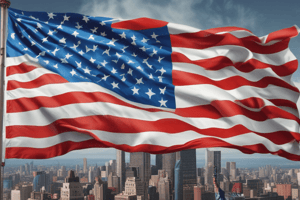Podcast
Questions and Answers
What factors contributed to the emergence of American isolationism?
What factors contributed to the emergence of American isolationism?
Factors included belief in American exceptionalism, aversion to alliances, fear of European conflicts, anti-immigration sentiment, and desire to protect freedom and sovereignty.
Who were some key figures that advocated for American isolationism?
Who were some key figures that advocated for American isolationism?
Senators Henry Cabot Lodge and Hiram Johnson.
What was President Woodrow Wilson's proposal in his Fourteen Points?
What was President Woodrow Wilson's proposal in his Fourteen Points?
An international organization, the League of Nations.
Why did many Americans struggle to accept the concept of the League of Nations?
Why did many Americans struggle to accept the concept of the League of Nations?
What major event in 1919 influenced American isolationism?
What major event in 1919 influenced American isolationism?
How did American isolationism aim to preserve the nation's role on the world stage?
How did American isolationism aim to preserve the nation's role on the world stage?
What was the main reason the Senate rejected President Wilson's plea to join the League of Nations?
What was the main reason the Senate rejected President Wilson's plea to join the League of Nations?
What was the purpose of the Washington Naval Treaty signed in 1922?
What was the purpose of the Washington Naval Treaty signed in 1922?
What did the Neutrality Acts passed by Congress beginning in 1935 aim to achieve?
What did the Neutrality Acts passed by Congress beginning in 1935 aim to achieve?
Who founded the America First Committee in 1940?
Who founded the America First Committee in 1940?
Why did President Franklin D. Roosevelt advocate for collective security and American engagement in global affairs?
Why did President Franklin D. Roosevelt advocate for collective security and American engagement in global affairs?
How did the legacy of American isolationism shape foreign policy discussions following World War II?
How did the legacy of American isolationism shape foreign policy discussions following World War II?
Flashcards are hidden until you start studying
Study Notes
American Isolationism After World War I
After the devastating chaos of World War I (1914-1918), the United States, which had remained neutral throughout the conflict, found itself grappling with the question of its role in global affairs. A significant segment of the American population sought to preserve the nation's independence and preeminence on the world stage by promoting a foreign policy philosophy known as isolationism.
Origins of Isolationism
Isolationism emerged from a mix of factors, including:
- A deep-seated belief in American exceptionalism and uniqueness
- Aversion to entangling alliances
- Fear of European conflicts spreading to the U.S.
- Widespread anti-immigration sentiment
- A desire to protect America's freedom and sovereignty
This mindset was bolstered by figures like Senators Henry Cabot Lodge and Hiram Johnson, who advocated for a foreign policy focused on keeping the U.S. out of European conflicts.
Key Events and Policies
Several events and policies shaped American isolationism following WWI:
-
Wilson's Fourteen Points: In January 1918, President Woodrow Wilson presented his Fourteen Points, which included a proposal for an international organization, the League of Nations. However, many Americans struggled to accept the concept of collective security and international entanglements.
-
The Treaty of Versailles: In 1919, the U.S. Senate rejected President Wilson's plea to join the League of Nations, a decision that dealt a significant blow to the isolationist movement. Many Americans argued that the U.S. should not become involved in European affairs and that the League of Nations had too many flaws.
-
The Washington Naval Treaty: In 1922, the Washington Naval Treaty was signed by the U.S., Great Britain, France, and Japan, limiting the construction of battleships and cruisers. The treaty aimed to prevent an arms race and to reduce tensions among the signatories, but it also reflected American isolationist sentiments.
-
Neutrality Acts: Beginning in 1935, Congress passed several Neutrality Acts that aimed to prevent the U.S. from becoming involved in European conflicts. The acts restricted American arms sales and imposed an embargo on the delivery of weapons to warring nations.
-
America First Movement: The America First Committee, founded in 1940, was a prominent organization that sought to keep the U.S. out of World War II. The movement gained considerable support but ultimately failed to prevent the U.S. from entering the war.
Isolationist Critiques
Isolationism was not without its critics. Many Americans argued that the U.S. had a moral obligation to engage in international affairs and to promote democracy and peace. President Franklin D. Roosevelt, for instance, was an advocate for collective security and American engagement in global affairs.
Nonetheless, isolationism remained a powerful force in American politics and foreign policy debates for decades following World War I. Its influence waned during World War II, when the U.S. entered the conflict and emerged as a global superpower, but its legacy continues to shape American foreign policy discussions to this day.
Conclusion
American isolationism after World War I was driven by a complex mix of factors, including a deep-seated belief in American exceptionalism and a desire to protect the nation's sovereignty. The isolationist movement was marked by a series of key events and policies, such as the failure to join the League of Nations and the implementation of the Neutrality Acts. Despite its shortcomings, isolationism was a powerful force in American politics and foreign policy debates for decades following World War I. Isolationism and Nonintervention, 1914-1941. Federal Research Division, Library of Congress. Isolationism, 1919-1941. History.com. Isolationism, American Foreign Policy, 1920-1935. Library of Congress. America First Movement. National Archives.
Studying That Suits You
Use AI to generate personalized quizzes and flashcards to suit your learning preferences.




